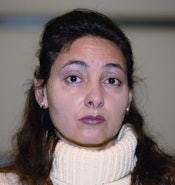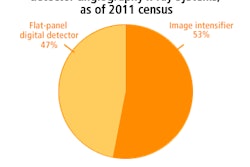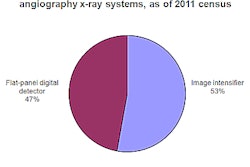
VIENNA - Correct diagnosis of osteoporosis is fundamental to identifying patients who require treatment and are at risk of complications. Dual-energy x-ray absorptiometry (DEXA) continues to prove itself as the heavyweight tool for both diagnosis and follow-up, European Congress of Radiology (ECR) delegates heard at yesterday's scientific session on osteoporosis and bone marrow.
Bone loss and fragility are an increasing issue after bariatric surgery, and radiologists have a key role to play. An Italian study presented on Thursday aimed to investigate the impact of bariatric treatment on body composition and bone metabolism over a period of 24 months following surgery and to determine the role of DEXA in the management of obesity.
"Results showed that body composition and bone metabolism are significantly modified after bariatric surgery, and that BMI (bone mass index) does not accurately reflect the real outcome of treatment. DEXA is useful for both bone and body composition assessments and should be considered in the clinical follow-up after bariatric surgery to help and guide clinicians in the management of patients," said Dr. Dani Diano, radiologist at Bologna University Hospital.
Session moderator Prof. Judith Adams, professor of diagnostic radiology at Manchester Royal Infirmary, U.K., pointed out that such studies were of great interest, given the rising incidence of obesity and its treatment by bariatric surgery, and the fact that DEXA was an excellent way to study the state of body composition and bone. However, some technical issues must be addressed. For instance, DEXA makes assumptions about body composition next to the bone. When there is weight gain or loss and there are changes in the muscle fat relationship, this will artificially affect bone mineral density (BMD).
"Whenever we look at weight change, we need to do some multivariate analysis, to see how much the weight change is contributing to the apparent change in BMD. In other words, we need a statistical way to look at the contribution of that artifact in the study. The amount of bone change might not be as big as was shown," she noted.
 Dr. Marianna Vlychou, assistant professor of radiology, University Hospital of Thessalia, Larissa, Greece. Image provided by ESR.
Dr. Marianna Vlychou, assistant professor of radiology, University Hospital of Thessalia, Larissa, Greece. Image provided by ESR.Maximum weight that DEXA tables could take was another factor to consider, said co-moderator Dr. Marianna Vlychou, assistant professor of radiology, University Hospital of Thessalia, Larissa, Greece.
"Tables usually take a maximum weight of 150 kilos, which means that some very obese patients will be precluded from current studies," she commented. "Manufacturers are now making MR, CT, and DEXA tables that take more weight as a reflection of increasing body sizes."
Another issue to be addressed is the impact of exercise on bone loss.
"There might be interaction between body composition, BMD, exercise, and weight loss. When people lose weight, they may lose bone as well. Whether they can prevent this sufficiently with exercise is a point that needs to be explored," she said.
At the same session, Turkish radiologists revealed the latest results on MRI studies of osteoporosis. Their purpose was to assess the value of fat fraction (FF) and T2* for the investigation of bone mineralization level using a new MR technique (iterative decomposition of water and fat with echo asymmetry and least squares estimation quantification; T2*-IDEAL) in perimenopausal women.
In simple terms, bone loss is replaced by marrow fat. An ordinary MR in the osteoporotic spine would have a higher signal on the fat-sensitive sequences than conventional ones to provide an idea of osteoporosis presence. Researchers attempted to correlate fat and the percentage of fat in the bone marrow and determine if this is an indicator of osteoporosis.
"FF is a reliable technique for the investigation of vertebral FF and has a high sensitivity and specificity in predicting presence of reduced bone mineralization," said Dr. Bilge Ergen, radiologist at Hacettepe University Faculty of Medicine, Ankara. "However, the study showed that T2* is not particularly helpful for the determination of bone mineralization level."
Sophisticated techniques such as high-resolution CT and high-resolution MR are being increasingly used to study osteoporosis, although many of them remain problematic. Not all departments have the facilities, particularly for trabecular bone studies. So far, such studies look set to be indicators of what disease and treatment is doing to the bone, and yesterday's session constituted a valuable benchmark of where research into osteoporosis is heading.
"Rather than having an impact on clinical diagnosis in daily practice, such studies will improve our understanding of the effect of disease and treatment on bone," Adams said.
Issues to overcome are reproducibility and precision of measurements. The amount of fat in the vertebra and its relation to bone marrow density is not yet clear, added Vlychou.
All these techniques are competing against widely available DEXA, which boasts hardly any radiation dose and automatic analysis, is quick to acquire, and has good reproducibility and plentiful fracture data.
"The limitations of DEXA drive the more sophisticated methods to look in more detail at bone, but in clinical practice DEXA will be a difficult technique to supersede. The other techniques will augment it rather than replace it," Adams told ECR Today.
Originally published in ECR Today March 2, 2012.
Copyright © 2012 European Society of Radiology



















